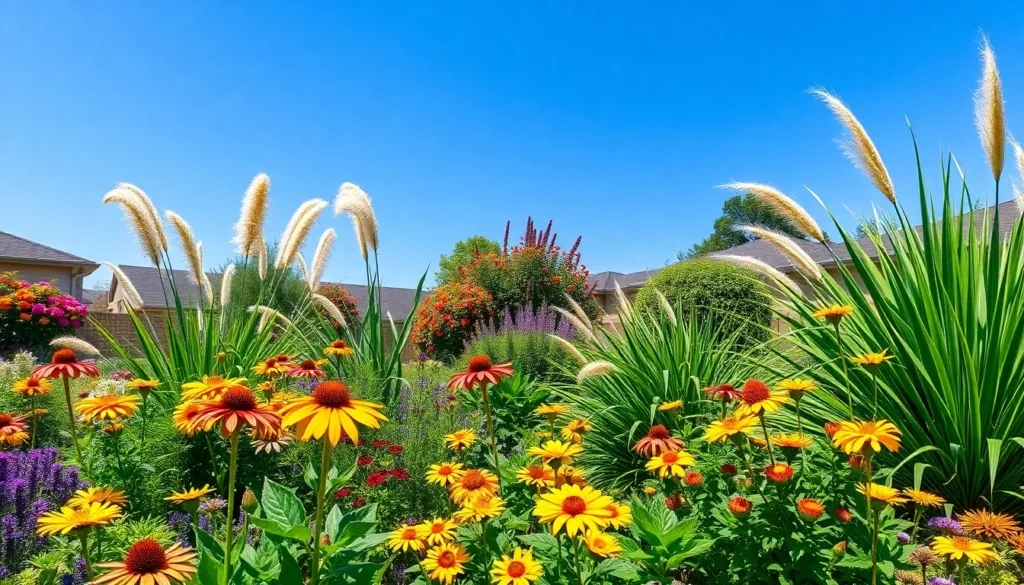We’ve all dreamed of that perfect outdoor space where vibrant colors thrive and lush greenery flourishes under the bright sun. Full sun landscaping transforms ordinary yards into stunning sanctuaries that celebrate nature’s most resilient and beautiful plants.
When we design landscapes for areas receiving six or more hours of direct sunlight daily we’re working with some of the most spectacular plant varieties available. These sun-loving champions don’t just survive in intense light – they absolutely thrive and reward us with bold blooms explosive growth and incredible visual impact that shade plants simply can’t match.
The secret lies in understanding which plants actually crave that abundant sunshine and how to arrange them for maximum effect. We’ll explore proven strategies for creating breathtaking full sun gardens that remain gorgeous throughout the seasons while requiring minimal maintenance once established.
Choose Hardy Perennials for Year-Round Full Sun Landscaping
Hardy perennials form the backbone of successful full sun landscaping because they return year after year with minimal care requirements. These resilient plants establish deep root systems that withstand drought conditions while providing consistent blooms throughout growing seasons.
Purple Coneflower (Echinacea)
Purple coneflowers deliver stunning pink, purple, and white blooms from midsummer through early fall while attracting beneficial pollinators like butterflies and bees. We recommend planting these native perennials in USDA zones 3-9 where they’ll thrive in well-draining soil with full sun exposure. Each plant grows 2-4 feet tall and spreads 18-24 inches wide, creating impressive displays when planted in groups of three or five.
Maintenance requirements stay minimal once established, as purple coneflowers tolerate drought conditions and resist most pests and diseases. Deadheading spent blooms encourages continuous flowering, though leaving some seed heads provides winter interest and food for birds. These adaptable perennials self-seed readily, creating natural colonies that expand your garden over time.
Black-Eyed Susan (Rudbeckia)
Black-eyed Susans produce cheerful yellow daisy-like flowers with dark centers from summer through fall, brightening any full sun industry with their vibrant colors. These North American natives thrive in USDA zones 3-9 and tolerate various soil conditions, including clay, sandy, and rocky soils that challenge other perennials. Plants reach 1-3 feet in height depending on the variety, with compact cultivars like ‘Goldsturm’ staying under 2 feet tall.
Drought tolerance makes black-eyed Susans perfect for low-maintenance landscaping, requiring water only during extended dry periods. We suggest cutting plants back to 6 inches in late fall or early spring to promote vigorous new growth. These prolific bloomers attract butterflies and goldfinches while deterring deer and rabbits from your garden.
Lavender
Lavender transforms full sun landscapes with its fragrant purple spikes and silvery foliage that remains attractive throughout the year. This Mediterranean perennial thrives in USDA zones 5-9 when planted in well-draining, slightly alkaline soil with excellent air circulation. English lavender varieties like ‘Hidcote’ and ‘Munstead’ offer the best cold hardiness for northern gardens.
Pruning after flowering prevents woody growth and maintains compact, bushy plants that produce abundant blooms. We recommend harvesting flower spikes just as buds begin to open for the strongest fragrance and best drying results. Lavender’s natural pest-repelling properties protect nearby plants from aphids, moths, and other common garden insects.
Daylilies
Daylilies offer endless variety with thousands of cultivars featuring different colors, sizes, and bloom times that extend flowering seasons from early summer through fall. These reliable perennials adapt to USDA zones 3-9 and tolerate various soil conditions while producing trumpet-shaped flowers in shades of yellow, orange, red, pink, purple, and near-white. Modern varieties include repeat bloomers that produce multiple flushes of flowers throughout the growing season.
Dividing clumps every 3-4 years maintains vigorous growth and provides new plants for expanding your industry or sharing with neighbors. We suggest choosing a mix of early, mid, and late-season varieties to ensure continuous blooms from June through September. Daylilies combine beautifully with ornamental grasses and other full sun perennials in mixed borders and foundation plantings.
Select Colorful Annuals to Brighten Your Full Sun Garden
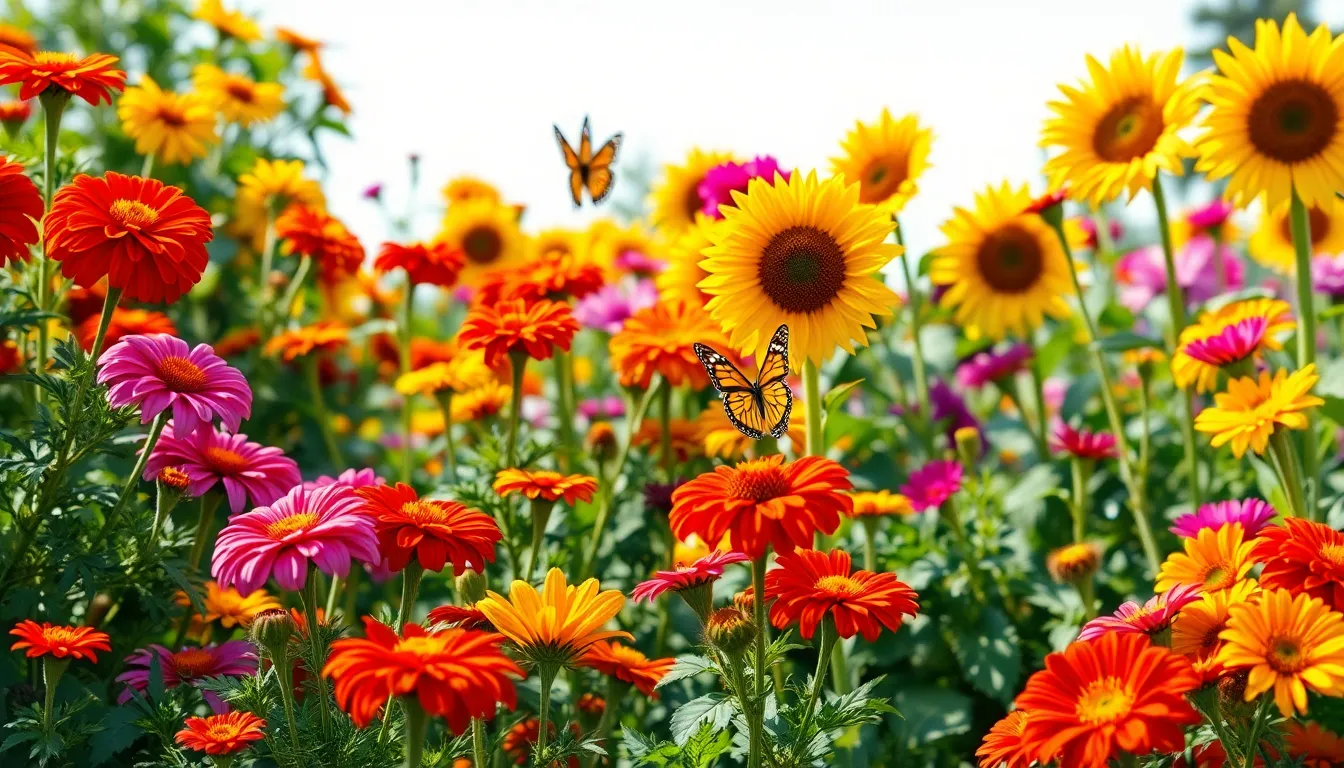
While hardy perennials form the backbone of our full sun industry, colorful annuals add vibrant seasonal interest that transforms ordinary gardens into stunning displays. These heat tolerant blooms provide continuous color throughout the growing season and complement our established perennial framework perfectly.
Marigolds
Marigolds deliver reliable color and pest deterrent benefits that make them essential for full sun landscaping. These hardy annuals thrive in temperatures that would wilt other flowers, producing abundant blooms from spring until the first frost. French marigolds offer compact growth perfect for borders, while African varieties provide larger blooms ideal for focal points. We recommend planting marigolds near vegetable gardens since they naturally repel harmful insects and nematodes.
Zinnias
Zinnias create spectacular cut flower displays while requiring minimal maintenance in full sun conditions. These drought tolerant annuals come in heights ranging from 6 inches to 4 feet, allowing us to layer them throughout our garden design. State Fair Mix zinnias produce dinner plate sized blooms up to 5 inches across, while Profusion series offers smaller flowers with exceptional heat resistance. Butterflies and hummingbirds frequently visit zinnia flowers, adding wildlife interest to our industry.
Petunias
Petunias provide cascading color that works beautifully in containers and hanging baskets throughout our full sun areas. Wave petunias spread up to 4 feet wide, creating groundcover effects that suppress weeds naturally. Grandiflora types produce large 4 inch blooms perfect for dramatic impact, while multiflora varieties offer smaller flowers in greater abundance. We find that deadheading spent blooms encourages continuous flowering from late spring through fall.
Sunflowers
Sunflowers create impressive vertical elements that serve as natural focal points in our full sun industry design. Mammoth varieties can reach heights of 12 feet with flower heads measuring 12 inches across, while dwarf cultivars like Teddy Bear grow only 2 feet tall with fluffy double blooms. These annual giants attract beneficial pollinators during their blooming period and provide seeds for wildlife in autumn. We position tall sunflowers strategically to avoid shading smaller plants while maximizing their architectural impact.
Incorporate Drought-Tolerant Succulents for Low-Maintenance Appeal
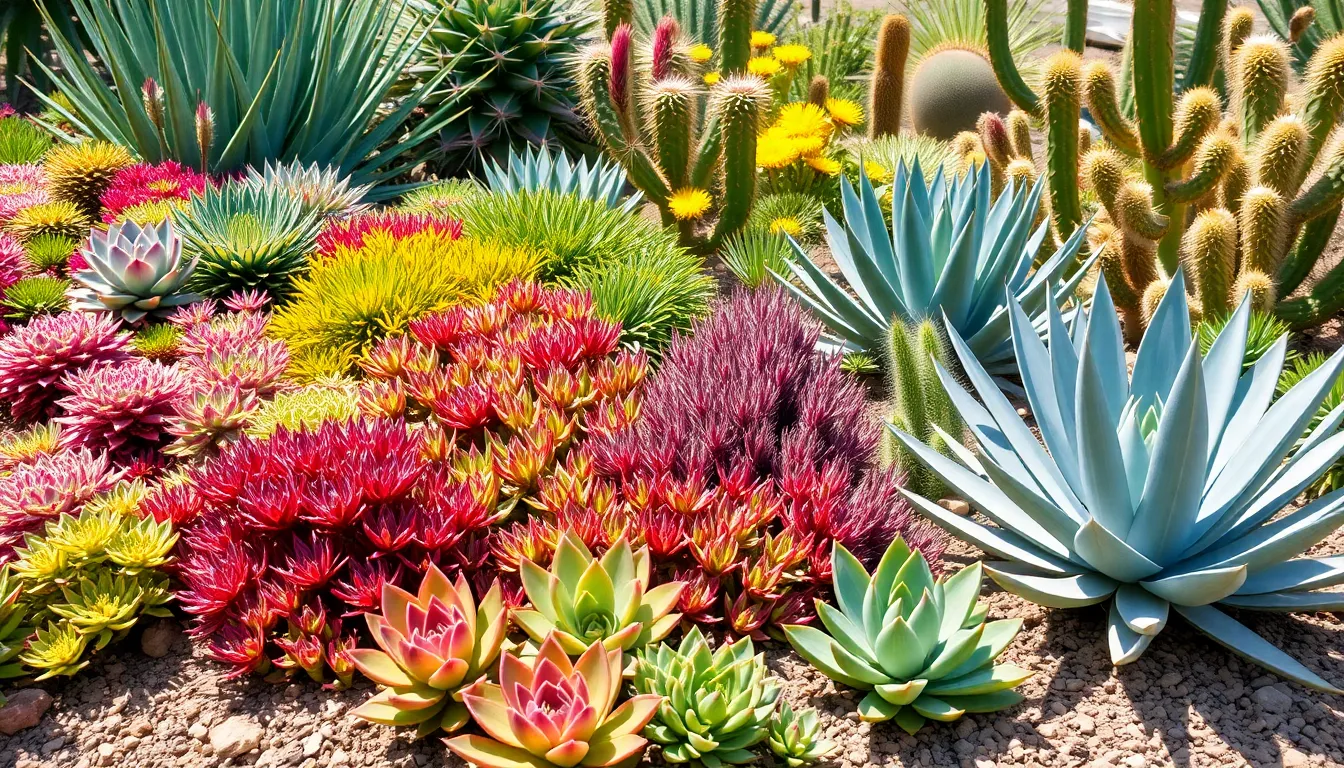
Succulents store water in their thick leaves or stems, allowing them to withstand intense sunlight while requiring minimal irrigation. Their diverse forms and textures create structural interest that complements the colorful perennials and annuals we’ve already discussed.
Sedum Varieties
Sedums flourish in full sun conditions across zones 3-11, making them incredibly versatile for various climates. These hardy succulents produce colorful foliage and star-shaped flowers that attract beneficial pollinators to your garden. Well-drained soil is their primary requirement, and they adapt beautifully to borders, ground covers, or container arrangements. Drought tolerance makes sedums perfect companions to your established perennials, requiring watering only during extended dry periods. Their low-growing nature creates excellent transitions between taller plants like sunflowers and smaller annuals.
Hens and Chicks
Sempervivum thrives in full sun and poor soil conditions that would challenge other plants. These rosette-forming succulents propagate easily by producing small offsets around the parent plant. Dense mats form naturally as they spread, preventing weed growth and reducing garden maintenance. Rock gardens and pathway edging showcase their compact, ornamental appeal perfectly. Their ability to survive in harsh conditions makes them ideal for areas where traditional plants struggle to establish.
Agave Plants
Agaves serve as striking architectural focal points in desert or xeriscape gardens. Heat and drought resistance allow these succulents to thrive in the most challenging full sun locations. Sandy, well-draining soils provide the perfect growing medium for their extensive root systems. Minimal maintenance is required once they’re established, making them perfect for sustainable landscaping approaches. Their dramatic form creates visual impact that anchors garden designs and provides year-round structure.
Prickly Pear Cactus
Opuntia produces flat, paddle-shaped segments with protective spines and vibrant seasonal blooms. Hot, sunny, and dry climates provide ideal growing conditions for these extremely drought-tolerant cacti. Colorful flowers attract wildlife while adding textural interest to your full sun industry. Minimal water requirements make them perfect for water-wise gardening in regions with limited rainfall. Their unique form adds southwestern character that complements both traditional and contemporary garden styles.
Add Structure with Ornamental Grasses in Full Sun Areas
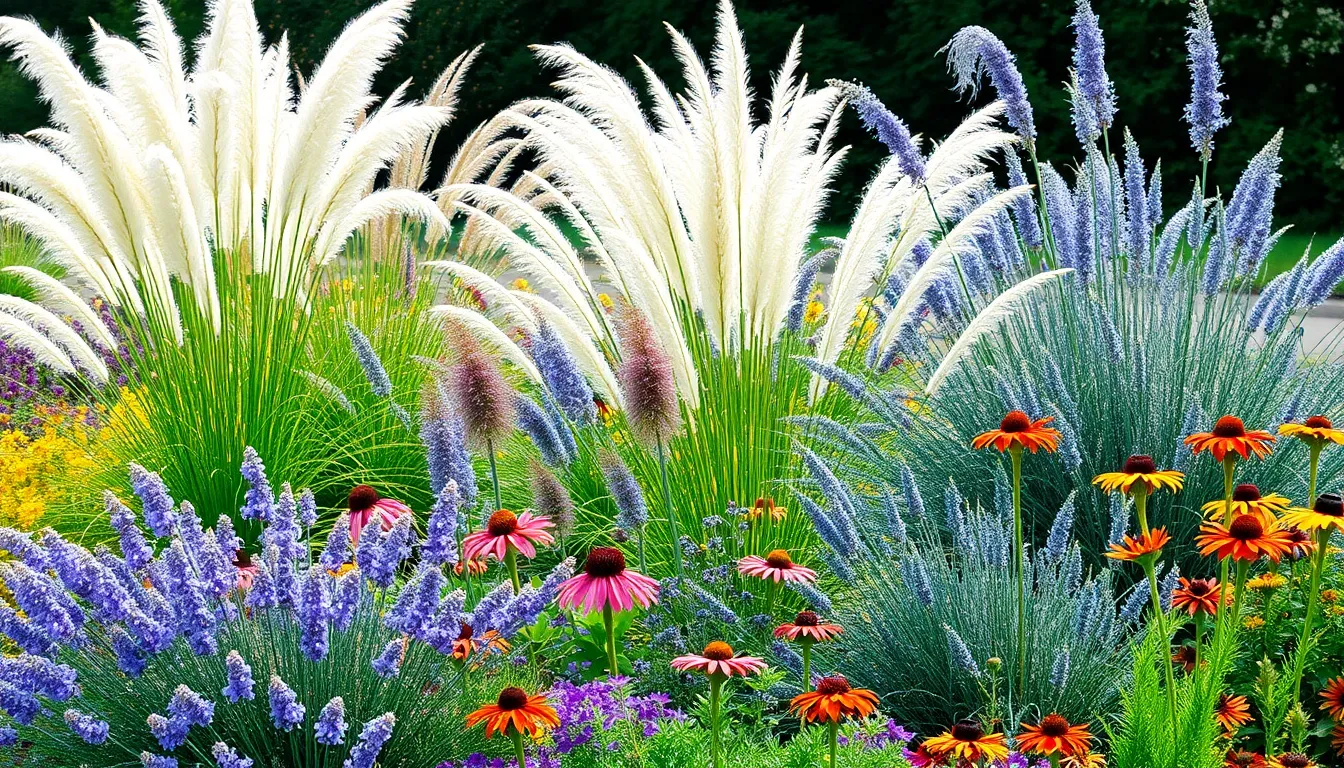
Ornamental grasses transform full sun landscapes by adding architectural elements that complement our colorful perennials and succulents. These resilient plants create ever-changing movement while requiring minimal maintenance in sunny conditions.
Fountain Grass
Fountain grass brings graceful arching form to our full sun gardens with its distinctive feathery flower spikes. We appreciate how this popular grass creates softness and movement as it sways attractively in breezes throughout the growing season. Thriving in six or more hours of direct sunlight, it performs exceptionally well in well-drained soil conditions.
Planting fountain grass in sunny borders provides an excellent backdrop for our colorful flowering plants. We often use it in containers where its cascading form creates stunning focal points on patios and decks. This versatile grass pairs beautifully with purple coneflowers and black-eyed Susans for contrasting textures.
Feather Reed Grass
Feather Reed Grass delivers striking vertical accents with its upright, narrow growth habit and distinctive feathery plumes. We value this grass for its exceptional heat and drought tolerance, making it perfect for exposed sunny locations where other plants struggle. Karl Foerster varieties reach impressive heights while maintaining their structural integrity throughout seasons.
Creating dramatic backdrops becomes effortless when we position feather reed grass behind lower growing perennials. We recommend grouping multiple plants together for maximum visual impact in our full sun designs. This architectural grass maintains its form even in windy conditions, providing year-round structure.
Blue Fescue
Blue Fescue adds unique color contrast to our sunny gardens with its striking blue-gray foliage that stands out among green plantings. We find this compact grass particularly valuable in rock gardens and sunny garden beds where its drought tolerance shines. Performing exceptionally well in hot, dry spots, it requires minimal irrigation once established.
Incorporating blue fescue as edging along pathways creates clean lines and interesting textural elements. We often plant it in groups to amplify its distinctive coloring and create cohesive design elements. This low-maintenance grass complements both warm and cool-colored flowering plants in our full sun landscapes.
Pampas Grass
Pampas grass commands attention as a dramatic focal point with its tall stature and large, fluffy flower plumes that tower above surrounding plants. We select this impressive grass for spaces where we want to create bold statements and year-round interest. Thriving in intense heat and full sun conditions, it demonstrates remarkable resilience in challenging environments.
Planning adequate space becomes crucial when we incorporate pampas grass due to its substantial mature size. We position it strategically as specimen plants or natural screens where its height creates privacy and wind protection. This architectural grass requires minimal care while delivering maximum visual impact in our full sun designs.
Create Stunning Borders with Full Sun Flowering Shrubs
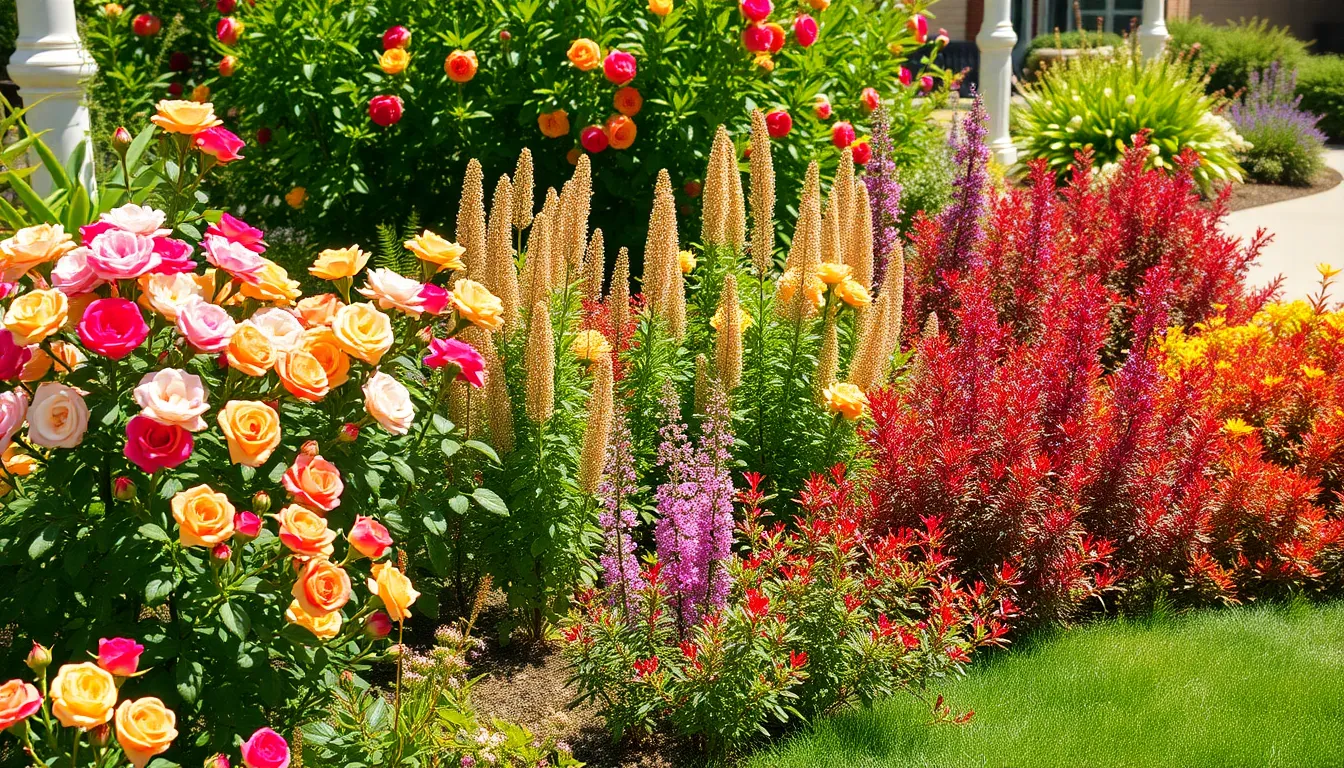
Flowering shrubs provide the perfect foundation for creating impressive borders in our full sun landscapes. These robust plants thrive with at least 6 hours of direct sunlight daily and deliver spectacular blooms that transform sun-drenched garden edges into vibrant focal points.
Rose Bushes
Rose bushes stand as the quintessential choice for elegant full sun borders with their spectacular blooms and intoxicating fragrance. Classic varieties flourish in direct sunlight, producing continuous waves of colorful flowers throughout the growing season. These showy shrubs adapt beautifully to various garden styles, from formal hedgerows to cottage garden borders.
Versatility makes roses ideal for different border applications, whether we’re creating privacy screens or accent plantings. Garden beds benefit from their structured growth habit, which provides excellent backbone plantings alongside shorter perennials. Proper spacing of 3-4 feet between plants ensures adequate air circulation and prevents disease issues.
Butterfly Bush
Butterfly bushes create magnificent displays with their long, fragrant flower spikes that attract pollinators throughout summer and fall. Purple, pink, and white varieties offer color options that complement any border design scheme. These shrubs excel in hot sun conditions, making them perfect for challenging south-facing locations.
Drought tolerance becomes evident once these plants establish their root systems, typically within the first growing season. Fragrant blooms continuously attract butterflies, bees, and hummingbirds, creating ever-changing wildlife corridors along our borders. Deadheading spent flowers encourages additional blooming periods and maintains tidy appearances.
Spirea
Spirea shrubs deliver exceptional value with their profuse clusters of small flowers and attractive foliage throughout multiple seasons. Tough, adaptable nature allows these plants to thrive in various soil conditions while maintaining excellent drought tolerance. Border plantings benefit from their compact, rounded growth habit that requires minimal pruning.
Flower clusters range from pristine white to soft pink, creating delicate textures that soften harsh industry lines. Foliage provides seasonal interest with spring emergence, summer fullness, and autumn color changes. Low maintenance requirements make spirea ideal for busy gardeners seeking reliable border performers.
Barberry
Barberry shrubs contribute striking foliage color and texture contrast to full sun borders with their vibrant red, yellow, and green leaves. Hardy, drought-tolerant characteristics ensure these plants survive challenging conditions without supplemental watering once established. Colorful foliage maintains its intensity throughout the growing season, providing consistent visual impact.
Low maintenance nature appeals to gardeners seeking reliable border plants that resist common pests and diseases. Thorny branches create natural barriers, making barberry excellent for security plantings along property lines. Compact varieties work well in smaller spaces, while larger cultivars create substantial hedge-like borders.
Design Seasonal Interest with Full Sun Bulbs and Tubers
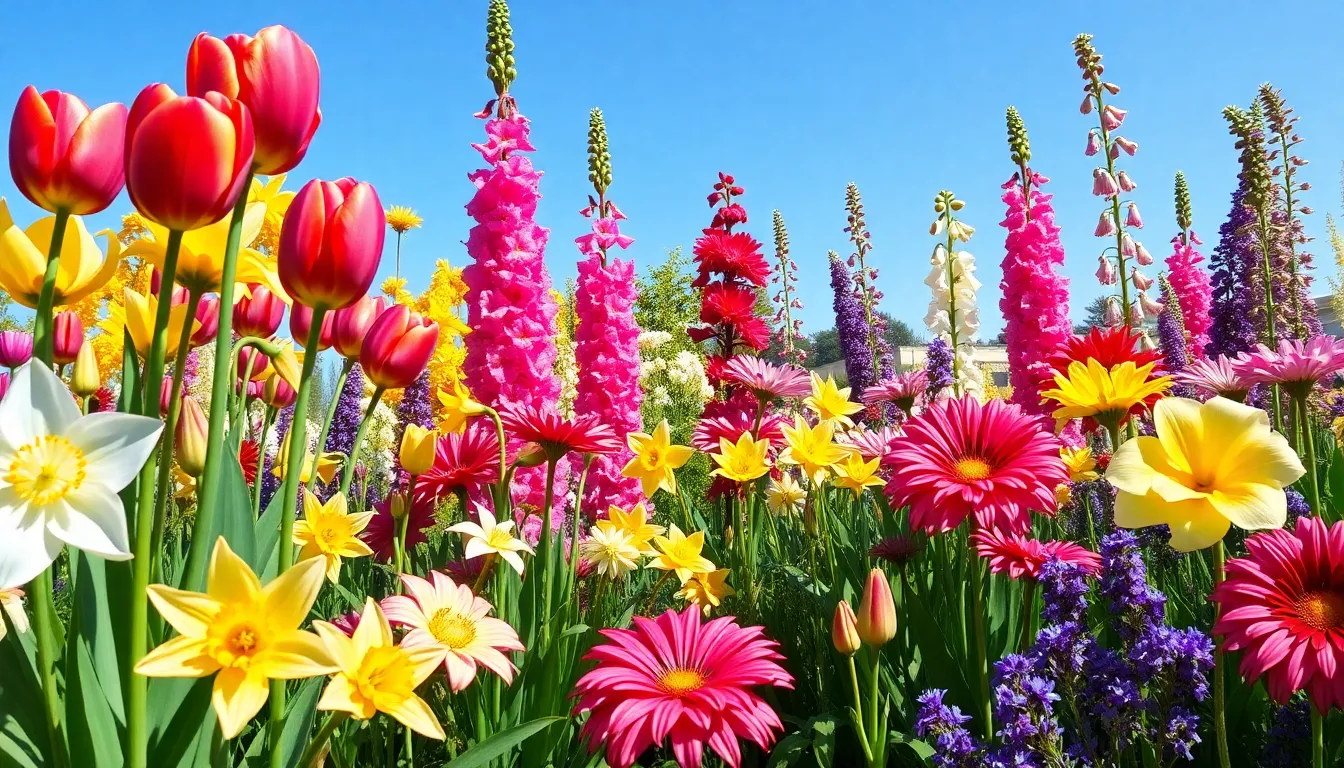
Creating year-round visual appeal in full sun landscapes becomes effortless when we incorporate bulbs and tubers that bloom throughout different seasons. These underground powerhouses provide defined bursts of color that complement our established perennials, annuals, and shrubs.
Tulips and Daffodils
Spring awakening begins with tulips and daffodils, the quintessential early season performers that thrive in full sun locations. Both species require at least 6 hours of direct sunlight daily and well-drained soil to prevent bulb rot during their dormant period.
Tulips offer an extensive color palette ranging from deep purples and bright reds to soft pastels and pristine whites. We can plant them in masses for dramatic impact or mix varieties for extended bloom times from early to late spring.
Daffodils provide cheerful yellow and white blooms that naturalize beautifully in sunny areas. These reliable performers return year after year with minimal care, making them perfect for low maintenance landscapes.
Both bulbs benefit from a cold dormant period and should be planted in fall for spring blooms. They kick off our garden season vibrantly after winter’s dormancy.
Gladiolus
Summer drama arrives with gladiolus, the tall flowering spikes that bring vertical interest to our full sun gardens. These summer blooming bulbs flourish in bright, sunny locations with regular watering and well-drained soil.
Gladiolus grow impressive flower spikes reaching 3 to 5 feet tall in colors including pink, red, purple, yellow, and white. We can stagger plantings every two weeks from spring through early summer for continuous blooms.
Their sword-like foliage adds structural interest even before the flowers appear. Gladiolus work exceptionally well as cut flowers, extending our garden’s beauty indoors.
These bulbs prefer fertile soil and benefit from staking in windy locations. They bloom from midsummer through early fall, bridging the gap between spring and autumn interest.
Dahlias
Midsummer magnificence comes from dahlias, the tuberous plants that flourish in full sun with rich, fertile soil. These showstoppers bloom continuously from midsummer until the first frost, offering the longest flowering season of any bulb.
Dahlias come in diverse shapes including dinner plate, pompom, cactus, and decorative forms. Their color range spans every hue except true blue, giving us endless design possibilities.
These plants add substantial texture and fullness to sunny borders and containers. We can choose compact varieties for front borders or towering types for dramatic backdrops.
Dahlias require consistent moisture and benefit from regular fertilizing throughout the growing season. They perform best when we provide afternoon shade in extremely hot climates.
Alliums
Architectural elegance defines alliums, the ornamental onions that produce distinctive spherical flower heads on tall stems. These unique bulbs bloom from late spring through early summer, creating stunning focal points in our full sun landscapes.
Alliums prefer sunny, well-drained locations and tolerate drought once established. Their globe-shaped flowers range from small 2-inch spheres to impressive 8-inch orbs in purple, pink, white, and yellow.
These striking plants attract beneficial pollinators including bees and butterflies to our gardens. Their sturdy stems make excellent cut flowers that dry beautifully for lasting arrangements.
Alliums work perfectly when planted among perennials where their foliage can be disguised as it dies back naturally. They return reliably each year with minimal care requirements.
Plan Your Layout for Maximum Visual Impact
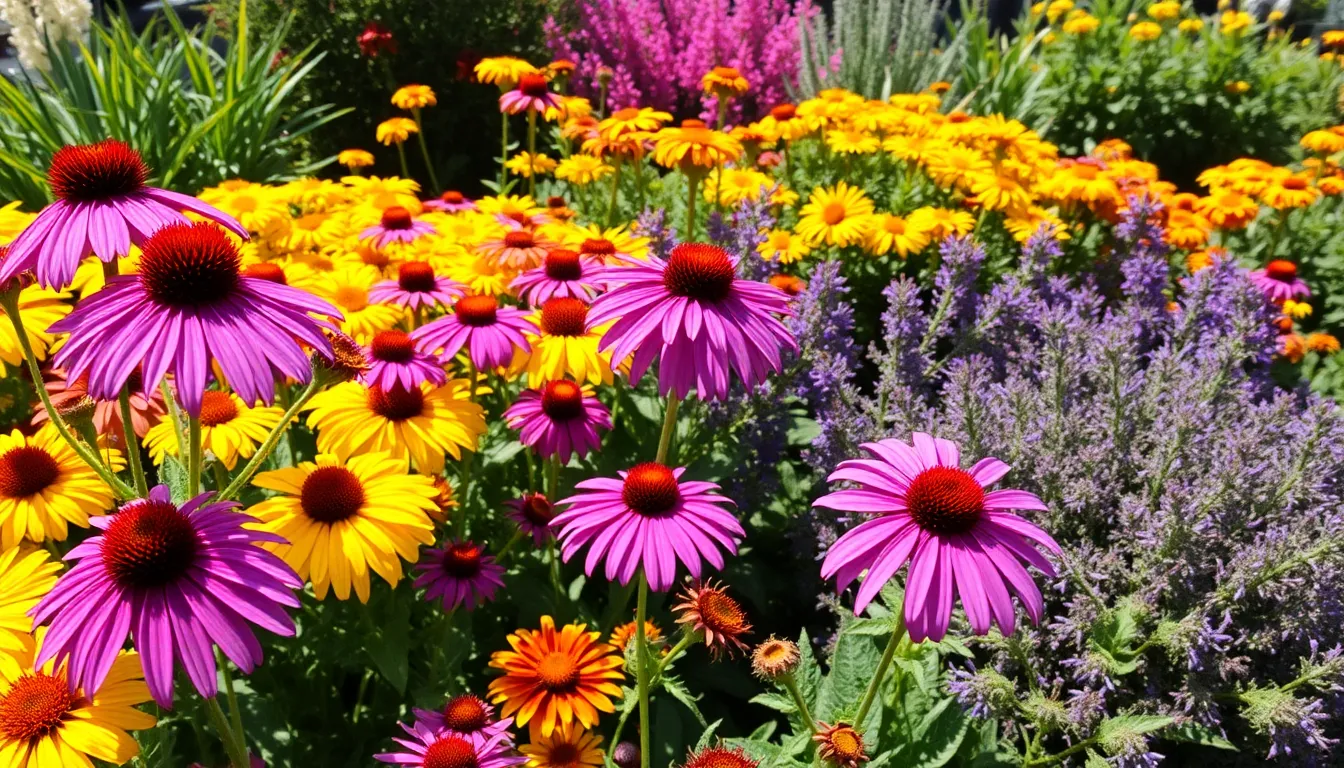
Creating a stunning full sun industry requires strategic planning that maximizes both visual appeal and plant health. We’ll focus on proven design principles that work specifically for plants requiring at least 6 hours of direct sunlight daily.
Color Coordination Strategies
Complementary color schemes create striking visual harmony in full sun gardens. We recommend pairing purple coneflowers with yellow blanket flowers for dramatic contrast that catches the eye from every angle. Analogous color combinations work equally well when you want a more subtle, sophisticated look.
Selecting plants with varying bloom times ensures continuous color throughout the growing season. Marigolds deliver vibrant yellows and oranges from summer through fall, maintaining visual interest when other plants begin to fade. California poppies add bright, cheerful color while thriving in less productive soils with minimal water requirements.
Layering different bloom periods creates a ever-changing industry that evolves seasonally. We suggest combining early bloomers like certain asters with mid-season performers such as daylilies and late-season champions like Russian sage for year-round appeal.
Height and Texture Combinations
Vertical layering maximizes visual impact by creating natural depth and dimension. We place taller plants like Agastache (ranging from 1-6 feet) at the back, medium-height specimens in the middle, and low-growing plants such as Sedum at the front of beds.
Contrasting textures add visual interest without requiring additional maintenance. Mixing fine-textured foliage like Russian Sage with broad-leaved plants such as daylilies creates compelling focal points that draw attention throughout the garden.
Combining upright growth habits with mounding or spreading forms prevents monotony. We pair vertical elements with horizontal spreaders to achieve balanced compositions that look professionally designed while requiring minimal ongoing care.
Seasonal Bloom Succession
Strategic timing ensures your full sun industry maintains color from spring through fall. We plan for early, mid, and late-season bloomers to create seamless transitions between flowering periods.
| Season | Plant Examples | Bloom Period |
|---|---|---|
| Early | Asters | Late summer to fall |
| Mid | Daylilies, Agastache | Summer to fall |
| Late | Marigolds, Russian Sage | Summer into fall |
Drought-tolerant and heat-loving species maintain their vibrant appearance in intense sun. Blanket flowers and purple coneflowers excel in hot conditions without fading quickly, making them reliable performers for challenging full sun locations.
Incorporating both perennials and annuals provides structure and seasonal flexibility. We use perennials like native sedums and daylilies for long-term framework, then add annuals such as marigolds and geraniums for bursts of seasonal color that can be changed yearly.
Maintain Your Full Sun Plant Landscape Successfully
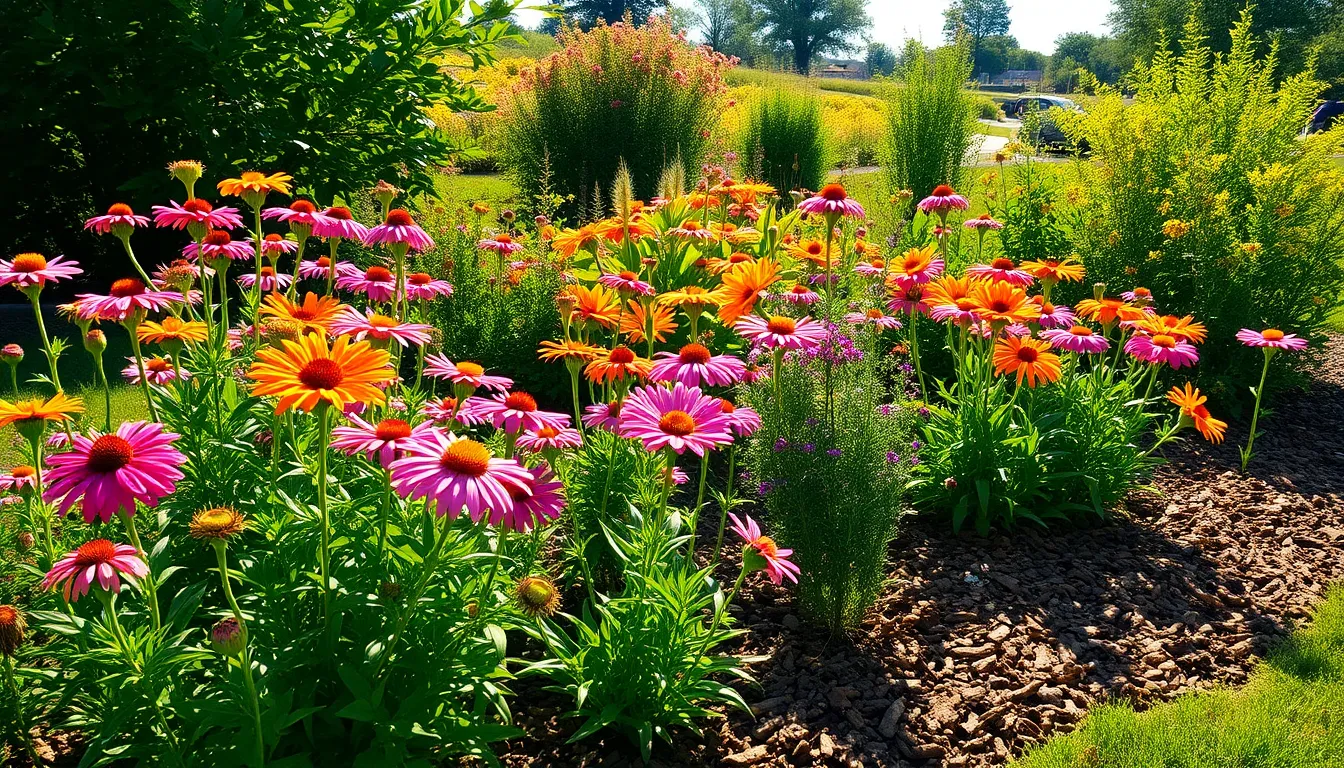
Once we’ve established our vibrant full sun garden with carefully selected plants, proper maintenance ensures these hardy species continue to thrive and provide stunning visual impact year after year.
Proper Watering Techniques
Deep, infrequent watering encourages robust root development in our full sun plants, making them more drought resistant over time. We should focus our irrigation efforts directly at the root zone rather than spraying the foliage, which can lead to fungal issues and water waste. Early morning watering sessions minimize evaporation losses while giving plants adequate moisture to withstand intense afternoon heat.
During heat waves or extended drought periods, we need to adjust our watering frequency to prevent plant stress without overwatering. Most full sun perennials like coneflowers and daylilies actually prefer slightly dry conditions between waterings. Monitoring soil moisture levels helps us determine when our plants truly need water versus when they’re simply showing temporary heat stress.
Mulching Best Practices
Applying a 2 to 3 inch layer of organic mulch around our full sun plants provides multiple benefits including moisture retention, soil temperature regulation, and weed suppression. We should keep the mulch several inches away from plant stems to prevent rot and pest issues. Organic materials like shredded bark, wood chips, or compost work excellently for most full sun species.
Annual mulch replenishment maintains its effectiveness as the organic matter decomposes and enriches our soil. We typically need to refresh mulch each spring before the growing season begins. Proper mulching reduces our watering needs by up to 30% while creating a polished, professional appearance in our full sun landscapes.
Pruning and Deadheading
Pruning our full sun shrubs like Russian sage and butterfly bushes promotes healthy growth patterns while maintaining their desired shape and size. We should deadhead spent flowers regularly on perennials such as asters and sedum to encourage continuous blooming throughout the season. This practice prevents energy waste on seed formation, redirecting plant resources toward producing more flowers.
Removing damaged or diseased foliage promptly maintains overall plant health and prevents problems from spreading to neighboring plants. Most full sun annuals like marigolds benefit from weekly deadheading sessions during peak growing months. Strategic pruning timing varies by species, with spring flowering shrubs pruned immediately after bloom while late season bloomers get pruned in early spring.
Conclusion
Creating a successful full sun industry becomes achievable when we combine the right plant selections with proper maintenance techniques. We’ve explored how hardy perennials colorful annuals drought-tolerant succulents ornamental grasses and flowering shrubs work together to build stunning outdoor spaces.
The key lies in strategic planning that considers bloom times color coordination and vertical layering. When we carry out proper watering schedules maintain adequate mulching and stay consistent with pruning we’ll enjoy vibrant gardens that thrive in intense sunlight.
Our full sun gardens will reward us with spectacular displays year after year while requiring minimal intervention once established. These sun-loving landscapes offer both beauty and sustainability making them perfect investments for any outdoor space.
Frequently Asked Questions
What is full sun landscaping?
Full sun landscaping involves designing outdoor spaces that receive six or more hours of direct sunlight daily. This approach focuses on using sun-loving plants that thrive in bright conditions, offering vibrant colors and impressive growth. Full sun gardens are typically more visually impactful and become low-maintenance once established, making them ideal for homeowners seeking stunning landscapes.
Which perennials work best in full sun gardens?
The best full sun perennials include Purple Coneflower for continuous blooms and pollinator attraction, Black-Eyed Susan for cheerful yellow flowers and drought tolerance, Lavender for fragrance and pest-repelling properties, and Daylilies for diverse colors and extended blooming seasons. These hardy plants require minimal care and develop deep root systems that withstand drought conditions.
What colorful annuals enhance full sun gardens?
Marigolds provide reliable color and pest deterrent properties, while Zinnias offer spectacular cut flowers with minimal maintenance. Petunias create cascading color in containers and hanging baskets, and Sunflowers serve as impressive vertical elements that attract beneficial pollinators. These annuals complement established perennials and create dynamic seasonal interest throughout the growing season.
How do succulents benefit full sun landscaping?
Succulents thrive in intense sunlight while requiring minimal irrigation, making them perfect for low-maintenance full sun gardens. Varieties like Sedum attract pollinators, Hens and Chicks form dense mats that reduce weeds, Agave plants serve as architectural focal points, and Prickly Pear Cactus adds unique texture. They contribute to sustainable gardening by minimizing water needs.
Which ornamental grasses work well in full sun areas?
Fountain Grass provides graceful form and movement, while Feather Reed Grass offers striking vertical accents with excellent drought tolerance. Blue Fescue adds unique blue-gray foliage in compact sizes, and Pampas Grass creates dramatic stature with fluffy flower plumes. All require minimal maintenance and enhance the overall design structure of full sun gardens.
What flowering shrubs create impressive full sun borders?
Rose Bushes offer spectacular blooms and fragrance, while Butterfly Bushes provide long, fragrant flower spikes that attract pollinators. Spirea produces profuse flower clusters with attractive foliage, and Barberry adds striking foliage color with excellent drought tolerance. These adaptable, low-maintenance shrubs enhance visual appeal and provide structural foundation for full sun landscapes.
How do bulbs and tubers add seasonal interest?
Spring bulbs like tulips and daffodils thrive in sunny locations with minimal care. Summer bloomers include Gladiolus for vertical interest and Dahlias for long flowering seasons with diverse shapes. Alliums provide architectural elegance while attracting pollinators. These plants complement established perennials, annuals, and shrubs, contributing to year-round visual appeal in full sun gardens.
What watering techniques work best for full sun gardens?
Use deep, infrequent watering to encourage robust root development and reduce plant stress during heat waves. Water early morning or late evening to minimize evaporation. Focus on watering at the base of plants rather than overhead to prevent fungal issues. Established full sun plants typically require less frequent watering due to their drought-tolerant nature.
How should I mulch my full sun garden?
Apply a 2 to 3 inch layer of organic mulch around plants for moisture retention and weed suppression. Keep mulch away from plant stems to prevent rot. Replenish mulch annually as it decomposes. Organic materials like shredded bark, compost, or wood chips work best, helping regulate soil temperature and reducing water evaporation in sunny conditions.
When should I prune and deadhead full sun plants?
Deadhead spent flowers regularly to promote continuous blooming throughout the season. Prune flowering shrubs after their bloom period ends to encourage next year’s growth. Cut back perennials in late fall or early spring. Remove damaged or diseased growth immediately. Proper timing ensures healthy plant development and maintains the vibrant appearance of your full sun landscape.

